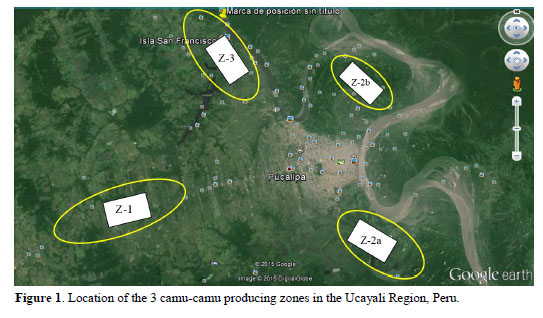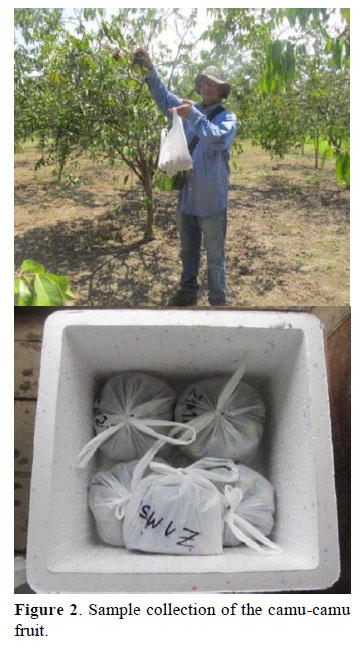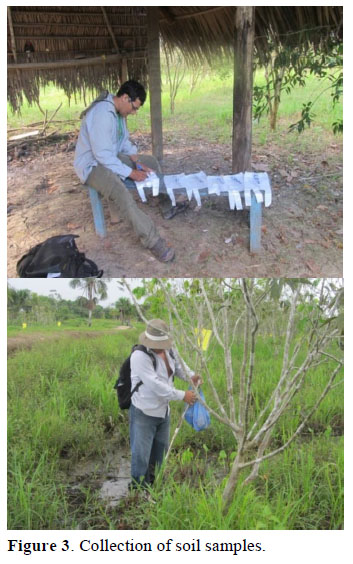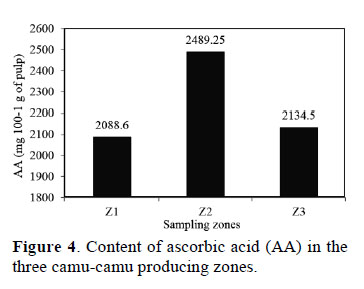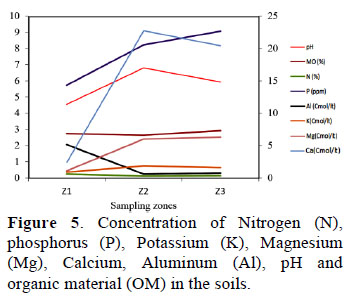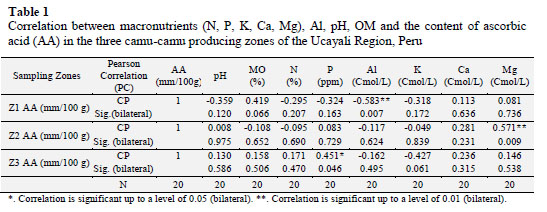Serviços Personalizados
Journal
Artigo
Indicadores
-
 Citado por SciELO
Citado por SciELO
Links relacionados
-
 Similares em
SciELO
Similares em
SciELO
Compartilhar
Scientia Agropecuaria
versão impressa ISSN 2077-9917
Scientia Agropecuaria vol.7 no.3 Trujillo jul./set. 2016
http://dx.doi.org/10.17268/sci.agropecu.2016.03.18
ARTÍCULOS ORIGINALES
Relation between the mineral nutrients and the Vitamin C content in camu-camu plants (Myrciria dubia) cultivated on high soils and flood soils of Ucayali, Peru
Carlos Abanto-Rodriguez1; Mario Pinedo-Panduro1; Edvan Alves-Chagas2; Pollyana Cardoso-Chagas3; Roberto Tadashi-Sakazaki3; Pedro Henrique Santos de Menezes3; Wellington Farias-Araújo3; Hipolito Murga-Orrillo4
1 Institute for Research of the Peruvian Amazon, Federico Basadre Highway, Km 12,400, Yarinacocha, Ucayali, Peru.
2 Embrapa Roraima Brazilian Agricultural Research Corporation, BR 174, Km 08, Industrial District, CEP: 69301-970, Boa Vista-Roraima, Brazil.
3 Federal University of RoraimaCenter for Agricultural Sciences Cauame Campus BR 174 s/n, km 12, Monte Cristo District, Brazil.
4 Universidad Nacional Autónoma de Chota (UNACH), Jr. Gregorio Malca Nº 875Campus Colpa Matara, Chota, Peru.
Abstract
Camu-camu is a native plant of the Peruvian Amazon. It is noted for its high concentration of ascorbic acid, however this feature varies widely from one location to another due to genetic and environmental factors. In order to determine the relationship between mineral nutrients and the concentration of ascorbic acid in camu>camu plants, a study was conducted in three camu-camu producing areas in flood-prone soils and soils on dry land conditions in the Ucayali Region. For this purpose, soil samples and camu-camu were collected. The content of following macronutrients was analyzed: nitrogen, phosphorus, potassium, calcium and magnesium; also was determined the concentration of aluminum, pH, organic matter and ascorbic acid. The results show that the camu-camu plantations located in upland soils had lower concentrations of ascorbic acid and lower natural fertility, than soils prone to flooding. Ascorbic acid is negatively related to the concentration of aluminum and positively to the concentration of magnesium and phosphorus in the camu-camu producing areas. It is concluded that the concentration of ascorbic acid in camu-camu plants is best expressed when soils have better chemical attributes and good conditions of natural fertility.
Key words: Myrciaria dubia, ascorbic acid, macronutrients, flooded soils, Peruvian Amazon.
1. Introduction
Just like gold, petroleum, wood and other enigmatic richness of the Amazon, the camu-camu is another gift that nature offers to humanity (Pinedo et al., 2010). It belongs to the Myrtaceae family and was described for the first time in 1823 by Humboldt, Bonpland and Kunth, as Psidium dubium HBK. In 1963, Rogers McVaugh reclassified this species to the genus Myrciaria and, later, it became known as Myrciaria dubia (Kunth) McVaugh (Silva, 2012). It is distinguished by its high content of ascorbic acid which varies from 845 to 7355.20 mg in 100 g-1 of pulp and for this reason, it has generated great interest in some European and Asian countries to be used in the pharmacological and nutritional industries (Yuyama et al., 2011; Chagas et al., 2015).
In Peru, the consumer demand for camucamu on the national market is recent. As recently as 2007, it was considered almost nil reaching only 5% of production whereas 95 % was exported to Japan (Chang, 2013). Within the last 4 years the export has diminished considerably due to a variation in the concentration of the vitamin C; this is a problem for the industry. This was confirmed by Yamakawa (2014), general manager of the Peru Amazon Export Company. He indicated that in the years 2006, 2007 and 2008, in order to be able to export camucamu pulp to Japan, it had to present a minimum content of 1800 mg of vitamin C per 100 g-1 of pulp, a situation which did not occur on certain occasions due to the large variation of vitamin C among fruit harvest locations. On the other hand, Iman et al. (2011) mentioned that the concentration of ascorbic acid also varies in the different parts of the fruit, as well as in the different stages of maturation. 1500 mg/100 g of AA is considered as the minimum value for commercialization within and outside of the country. The authors also mention that it is important to monitor the ascorbic acid content in camu-camu cultures coming from different locations and in different stages of maturation of the fruit for the control of pre and post-harvest factors.
According to Pinedo (2012); Iman et al. (2011); Teixeira (2004) and Yuyama (2002), the difference in vitamin C content among the different stages of maturation may be attributed to the existence of variability on the ecotypes and genotypes of the camu-camu, environmental factors of the different sourcing zones, water soil pH, temperature, existing nutrients which influence the biosynthesis of vitamin C and the level of flooding of the flood soils in the Amazon.
Reviewing the function of some of the mineral nutrients, it was noted that magnesium and manganese increased the value of the concentration of the determining components, such as citric acid and ascorbic acid. According to Hernández et al. (1970) and Franzão and Melo (2003), working on cherry plantations geared towards export, liming with phosphoric rock is an indispensable practice for pH correction of the soil for an increase in productivity and the ascorbic acid content of the fruit. In the same way, Welch (2016), in an article published on the nutritional quality of foods and the productivity of agricultural systems, ascertained that the concentration of vitamin C in fruits is also affected by macronutrients, and excessive fertilization with Nitrogen (N) reduces the concentration of vitamin C in fruits of many species such as melons, apples and citruses. As such, the objective of this study was to determine the relationship between mineral nutrients and vitamin C content in camu-camu fruits cultivated in dry land conditions and in flood prone soils of Ucayali, Peru.
2. Materials and methods
Soil and camu-camu fruit sample collection was done in camu-camu producing zones; the first located on soils on the right margin of the Federico Basadre Highway from km 10 to km 28 (Z1). The second was located on the margins of the Ucayali River, Pucallpillo township (Z2a) in the Manantay district, and Pacacocha (Z2b) located in the Callería district; and the third zone located on the margins of the Yarinacocha Lagoon, Padre Bernardo township, 07 de junio, Santa Rosa and San Juan de Yarinacocha (Z3). The first zone corresponds to dry land soils and the last two, to flood soils (Figure 1).
Collection area of camu-camu fruits for vitamin c analysis
In order to obtain vitamin C samples, 3 zones were selected in the Coronel Portillo Province, Ucayali Region; two of them were located on flood soils in an area at an altitude of ca 130 meters above sea level (m.a.s.l.). The first was located in a nonflood soil, that is, in dry land conditions at an altitude of 150 m.a.s.l. Natural sediments of the Ucayali River influence the second zone. Natural conditions of the Yarinacocha lagoon influence the third zone. In each zone, 4 sub-zones were selected, one consisting of 3 hectares with fruit producing plants between 8 and 10 years of age, separated by a distance of 1,000 m between them.
Then, in each sub-zone 5 parcels of 2500 m2 each were established. In each parcel, 10 plants were selected. From each plant 1 subsample of 100 g of fruit was taken, thus obtaining a sample of 1 kg of fruit per parcel. Accordingly, 20 samples were obtained per zone, assembling a total of 60 fruit samples (1 kg x 1parcel x 5 parcels x 4 sub-zones x 3 zones).
Sample collection of the camu-camu was done based on the protocol proposed by Pinedo et al. (2010). On This regard, the fruits were collected at 50 % maturation, on a sunny day at midday, and taken from the entire area of the crown. The fruits were collected directly from the plant and not from the ground. Furthermore, the fruits were in a clean state, without lesions, and pestand diseasefree Timing between collection and laboratory storage did not exceed 3 days. The samples were identified with markers with indelible ink suitable for freezing, and lastly were placed in Styrofoam boxes at around 10 ºC and taken for analysis (Figure 2).
In order to determine the vitamin C in the camu-camu samples, the Tillmans Volumetric Method was utilized, being more economical, and in many cases faster than the instrumental methods. The analyses were done at the NATURA ANALITICA Pucallpa laboratory.
Collection of soils for their physical and chemical analysis
Physical and chemical analysis of the soil is the most utilized methodology to evaluate the fertility of the soil and the availability of macro and micronutrients. In this study, due to subject matter proposed, only the following macronutrients were analyzed: phosphorus (P), calcium (Ca++), magnesium (Mg++), potassium (K+), aluminum (Al+++) and total Nitrogen (N); the content in terms of organic material (OM), pH and texture class was also determined. For soil sample collection, Filizola et al. (2006) methodology was used, for perennial crops. The simple samples or subsamples were taken from 3 points, one in front of the trunk of the plant, and two from the lateral part, close to the projection of the crown. Moreover, the collection was done in the post-harvest phase, since normally during this period neither fertilizer is applied nor is there natural fertilization taking place due to the fact that there are no floods at that time (produced by the rise of the rivers in the Amazon).
For sample collection, plastic buckets, plastic bags, a straight edged spade and a tubular soil samples were used in order to diminish the damage to the radicular system (Figure 3).
The zones from which the soil samples were collected were the same as those from which camu-camu fruit samples were collected. In this respect, each zone was divided into 4 sub-zones; in each sub-zone 5 parcels were delineated; in each parcel one soil sample was collected 0 to 25 cm and each sample was composed of 30 subsamples. In total 60 soil samples were collected (1 sample x 5 parcels x 4 sub-zones x 3 zones). Once obtained, the sample was combined in a plastic bag, identified with the name of the zone, number of the sub-zone and number of the parcel, name of the farmer, sample depth, and date and name of the person who took the sample. Subsequently, the samples were taken to the IIAP for preparation, conditioning and thereafter to the laboratories of INIA Pucallpa for their respective analyses.
The correlational method was utilized in order to measure the level of the existent relationship between the mineral nutrients and vitamin C, and for that, the Pearson correlation coefficient was used, which was calculated in the IBM-SPSS StatisticsSpanish version 19 statistical program.
3. Results and discussion
Regarding Content of Ascorbic Acid (AA) in the camu-camu fruits of the 3 productive zones, in Figure 4 the largest concentration of AA is found in zone 2 (Z2) with an average value of 2489. 25 mm/100g of pulp, followed by zone 3 (Z3) with an average value of 2134.5 mg, and lastly zone 1 (Z1) with an average value of 2088.6 mm/100g of pulp. These results confirm what was cited by authors Pinedo (2012); Imán et al. (2011); Teixeira (2004) and Yuyama et al. (2002), when they indicated that vitamin C content varies in function of the collection location.
In relation to content of the mineral elements, pH and organic material (OM), it may be observed in Figure 5 that zone 1, possesses elevated concentrations of aluminum Al (Cmol/L) because the samples were taken on high soils which are characterized by low natural fertility and high acidity (73% affected from aluminum toxicity). Moreover, they are usually deep and well drained, exhibiting a marked increase in clay content with depth. As a consequence of the high concentrations of aluminum, the absorption, transport and use of various essential elements such as Cu, Zn, Ca, Mg, Mn, K, P and Fe is reduced (Campillo and Sadwadka, 2008). At the same time, it is observed that the pH is low (4.55) indicating that this type of soil is extremely acid based on the INIA classification. For this reason, in Figure 5 it is observed that calcium, magnesium and phosphorus contents are extremely low. Further it may be affirmed that the low concentration of pH affects the availability of mineral nutrients (cations) for the plants (Campillo and Sadwadka, 2008).
In Table 1 it is observed that in zone 1 (Z1) Ascorbic Acid (mm/100 g of pulp) and the element Aluminum (Al) have a significant negative correlation given that they presented a p-value of 0.007 (p < 0.01). In this first case, the value of r2 is -0.583. It means that there is a negative correlation.
In this regard, it becomes clear that these characteristics are correlated in an inverse sense, meaning that high values in one variable correspond to low values in the other and vice versa. This is possible since many cultivated plants are sensitive to high concentrations of Al, making it one of the metals that most limit growth, productivity and quality of harvest in the acidic soils of the world (Campillo and Sadwadka, 2008). In the same way it is observed on Table 1 that in zone 2 (Z2) AA (mm/100 g of pulp) and magnesium have a positive correlation, given that this correlation presents a pvalue of 0.009 (p < 0.01). In this case the value of r2 is 0.571; this means that there is a moderate correlation.
For zone 3 (Z3) it is observed that AA (mm/100 g of pulp) and the macronutrient P (ppm) present a positive correlation, given that the correlation has a p-value of 0.046 (p < 0.05). The value of r2 in this case is 0.451, which means that there is a moderately positive correlation. In these cases, having positive correlations means that the two variables are directly related, that is, the high values of one variable corresponds to high values in the other and the same correlations may be deduced with the low values.
Based on what is effectively observed in this preliminary study, it becomes clear that certain mineral elements correlate with the content of ascorbic acid in camu-camu fruits of these productive zones. Moreover, if we observe Figures 4 and 5 it is clearly shown that the concentration of ascorbic acid was higher when the soil (Z2, Z3) presented better chemical attributes. These two camu-camu producing zones are flood soils, formed by the accumulation of sediments deposited by waters of the rivers and lagoons every year, having the characteristic of being alluvial and of showing neutral pH reactions and better natural fertility when compared with soils at high elevation. They also present a high saturation of the bases, good capacity for cations interchange, high organic material content, nitrogen, phosphorus, calcium and potassium (Sales, 2006).
The results found in this study agree with Dios et al. (1962) who concluded that certain inorganic elements such as manganese and magnesium increase the content of vitamin C in plants. According to these investigators, in studies done in potato cultivation, plants with a low concentration of ascorbic acid recovered their normal level after two years of addition of magnesium in the soil. The same authors noted that foliar application of magnesium in potato plants increased the concentration of ascorbic acid from 2.5 to 15.7 mg per 100 grams of tuber. On the same note Fontes et al. (2000), in studies conducted in the cultivation of tomato, noticed that potassium increased the vitamin C content, total acidity and sugars in the fruits.
Relatedly, Lee and Kader (2000) also indicated that the concentration of vitamin C in fruits and vegetables can be influenced by various factors such as the genotypic differences, the climatic conditions preceding harvest, practices in cultivation, methods of maturation, and harvest and post-harvest. Furthermore, the authors mention that another important factor is the intensity of the light: the greater this is during the growth season of the plant, the greater will be the concentration of vitamin C in the vegetal tissues.
On the other hand, Castro et al. (2013) mention that Myrciaria dubia presents a wide content variation of vitamin C and anthocyanins in its fruits, principally due to the influence of genetic factors. There is no doubt that the high concentration of ascorbic acid in camu-camu is genetic. Nevertheless, it is also established that this characteristic is more expressed when the plants are grown in fertile soils. Correspondingly, Pinedo (2012) working on an analysis of the correlation and heritability in genetic improvement of the camu-camu, noted from that study that the heritability of the "content of ascorbic acid" characteristic was very low (h2g=0.0025) and further affirmed that the concentration of AA is significantly influenced by environmental factors. The same was observed by Yuyama et al. (2002), who registered very different values of ascorbic acid from one year to the next on the same plant in its natural environment in an apparent correlation with the level of the crest of the river.
Pinedo (2013), for the PALMAGRO Company registered a similar case, where a plant during the first year produced 5200 mg of vitamin C per 100g-1 of pulp, and in the following year produced only 3300 mg of vitamin C per 100g-1 of pulp.
According to the literature, one of the causes of the variation of the concentration of ascorbic acid in the plants is the excess of nitrogenized fertilization. Abanto et al. (2011) verified this in a study done with N P-K fertilization in adult camu-camu plants. The National Plant Food Institute (2010) and Welch (2016) also confirm that the concentration of vitamin C in fruits is affected by macronutrients, and the excess of fertilization with N reduces the concentration of vitamin C in fruits of many species such as melons, apples and citruses. In this study, this effect was not manifest given that in the three zones the N content was similar and furthermore, there were no reports of nitrogenized fertilization in the studied zones.
With respect to camu-camu plantations in firm land conditions, soil correction and appropriate fertilization is recommended in order to achieve optimum results for productivity and concentration of ascorbic acid, in the manner done by Hernández et al. (1970) and Franzão and Melo (2003). On plantations of cherry cultivated for export, the authors added lime with rock phosphate in order to correct the pH of the soil, boost productivity and the ascorbic acid content in the fruit.
4. Conclusions
Under the conditions in which this study was conducted, it may be concluded that: In this first study, ascorbic acid relates negatively with the concentration of aluminum and positively with the concen tration of magnesium and phosphorus in the zones analyzed.
It is recommended perform further studies in other plantations of camu-camu, in order to determine and confirm the relation between the concentration of ascorbic acid in camu-camu with (i) the macronutrients, (ii) micronutrients, (iii) pH, Organic matter (iv) quality of water and (vi) level of flooding of the lagoons and rivers.
The concentration of ascorbic acid in camu-camu plants is well expressed when the soils present better conditions of natural fertility.
Acknowledgements
The authors wish to thank the Institute for Research of the Peruvian Amazon for the financial support and the agriculturalists for having allowed us to conduct the studies on their camu-camu plots.
References
Abanto, C.; Oliva, C.; Domínguez, G.; Meza, A.; Alves, E. 2011. Fertirriego en la producción del camu-camu (Myrciaria dubia HBK Mc Vaugh) en la estación experimental del IIAP, Ucayali, Perú. Scientia Agropecuaria 2 (3): 157-167. [ Links ]
Campillo, R.R.; Sadzawaka, R.A. 2008. La acidificación de los suelos, origen y mecanismos involucrados. INIA Chile, Acta NR33853: 44-60. Available in: http://www2.inia.cl/medios/biblioteca/serieactas/NR33853.pdf [ Links ]
Castro, J.C.; Gutiérrez, F.; Acuña, C.L.A. Cerdeira, L.A.; Tapullima, A.; Cobos, M.; Imán, S.A. 2013. Variación del contenido de vitamina c y antocianinas en Myrciaria dubia "camu-camu" Rev. Soc. Quím. Perú 79 (4): 319-330. [ Links ]
Chagas, E.A.; Lozano, R.M.B.; Chagas, P.C.; Bacelar Lima, C.G.; García, M. I. R.; Oliveira, J.V.; Souza, O.M.; Morais, B.S.; Araujo, M.C.R. 2015. Intraspecific variability of camu-camu fruit in native populations of northern Amazonia. Crop Breeding and Applied Biotechnology 15: 265-271. [ Links ]
Chang, A.C. 2013. El camu-camu. Aspectos químicos y tecnológicos. 1. ed. Ica. Lima. Abril, 2013. 156p. [ Links ]
Dios, G.; Dios, R.; Sanchez, B. 1962. Efecto del roceado foliar en el contenido del ácido ascórbico de los tubérculos de patatas. In Control químico del magnesio y Manganeso. Available in: http://digital.csic.es/handle/10261/60573 [ Links ]
Filizola, H.F.; Gomes, M.A.F.; Souza, M.D. de. 2006. Manual de procedimentos de coleta de amostras em áreas agrícolas para análise da qualidade ambiental: solo, água e sedimentos. Empresa Brasileira de Pesquisa Agropecuária (EMBRAPA) Meio Ambiente, Ministério da Agricultura, Pecuária e Abastecimento. Jaguariúna, SP. Brazil. 169 p. [ Links ]
Fontes, P.C.R.; Sampaio, R.A.; Mantovani, E.C. 2000. Tomato yield and potassium concentrations in soil and in plant petioles as affected by potassium fertirrigation. Pesquisa Agropecuária, Brasília 35 (3): 575-580. [ Links ]
Franzão, A.A.; Melo, B.A. 2003. A cultura da aceroleira. Edit. Núcleo de estudo em fruticultura no Cerrado, Universidade Federal de Uberlandia, Instituto de Ciencias Agrarias. Available in: http://www.fruticultura.iciag.ufu.br/aceroleira.htm. [ Links ]
Hernández, M. E.; Velez, S. J.; Lopez, M.A. 1970. Root development of acerola trees affected by liming. C. Abanto-Rodriguez et al. / Scientia Agropecuaria 7 (3) 297 – 304 (2016) Journal of Agriculture of University of Puerto Rico 54 (1): 57-61.
Imán, C.S.; Bravo, Z.L.; Sotero, S.V.; Oliva C.C. 2011. Contenido de vitamina C en frutos de camu-camu. Myrciaria dubia (H.B.K) Mc Vaugh, en cuatro estados de maduración, procedentes de la Colección de Germoplasma del INIA Loreto, Perú. Scientia Agropecuaria 2(2011): 123-130. [ Links ]
Lee, S. K.; Kader, A. A. 2000. Preharvest and postharvest factors influencing vitamin C content of horticultural crops. Postharvest Biology and Technology 20 (3): 207-220. [ Links ]
Nathional Plant Food Institute. 1995. Manual de fertilizantes. Edt. Limusa. México. 285p. [ Links ]
Pinedo, H. 2013. Empresa PALMAGRO. Comunicación personal. [ Links ]
Pinedo, P.M. 2012. Análisis de correlación y heredabilidad en el mejoramiento genético del camu-camu. Scientia Agropecuaria 1: 23 – 28. [ Links ]
Pinedo, P.M.; Delgado, V.C.; Farroñay, P.R.; Imán, C.S.; Villacrés, V.J.; Faching, M.L.; Oliva, C.C.; Abanto, R.C.; Bardales, L.R.; Veja, V.R. 2010. Camu-Camu (Myrciaria dubia Myrtaceae): Aportes para su Aprovechamiento Sostenible en la Amazonía Peruana. Iquitos, FINCyT. 130p. [ Links ]
Welch, R.M. 2016. Micronutrients, Agriculture and Nutrition: Linkages for Improved health and well being. Plant, Soil and Nutrition Laboratory, USDAARS, U.S. Available in: http://www.css.cornell.edu/FoodSystems/Micros%26A griMan1ref.html [ Links ]
Sales, D.B. 2006. Caracterización de la materia orgánica de suelos representativos de ecosistemas amazónicos del Perú, departamento de Ucayali, e influencia de su uso y manejo en el secuestro del carbono. Tesis Doctoral. España. Universidad de Sevilla. 162p. [ Links ]
Silva, S.C. 2012. O Gênero Myrciaria O. Berg (MYRTACEAE) na Amazônia Brasileira. Dissertação de Mestrado. Universidade Federal Rural da Amazônia, Belém. 56p. [ Links ]
Teixeira, S.A.; Chaves, S.L.; Yuyama, K. 2004. Esterases no exame da estrutura populacional de Camu-camu (Myrciaria dubia (Kunth) McVaugh-Myrtaceae). Acta Amazônica 34 (1): 89-96. [ Links ]
Yamakawa, H. 2014. Empresa Peru Amazon Export. Comunicación personal. [ Links ]
Yuyama, K.; Agiar, J.P.L.; Yuyama, L.K.O. 2002. Camucamu: um fruto fantástico como fonte de vitamina C. Acta Amazônica 32 (1): 169-174. [ Links ]
Yuyama, K.; Mendes, N.B.; Valente, J.P. 2011. Longe vidade de sementes de camu-camu submetidas a diferentes ambientes e formas de conservação. Revista Brasileira de fruticultura 33 (2): 601-607. [ Links ]
* Corresponding author
E-mail: carforestal24@gmail.com (C. Abanto-Rodriguez).
Received May 23, 2016.
Accepted September 27, 2016.













